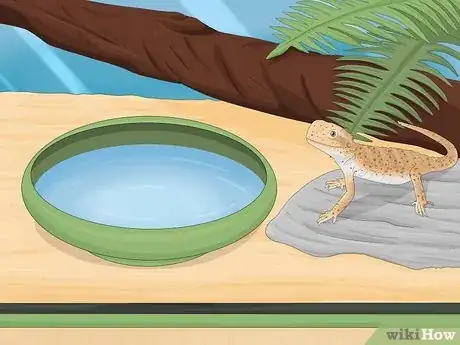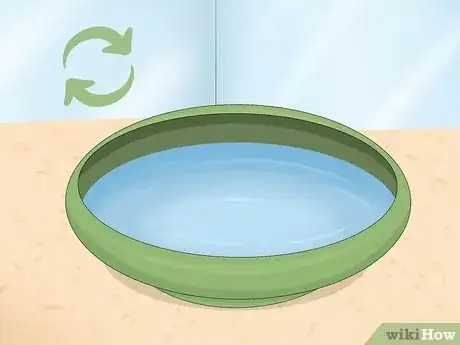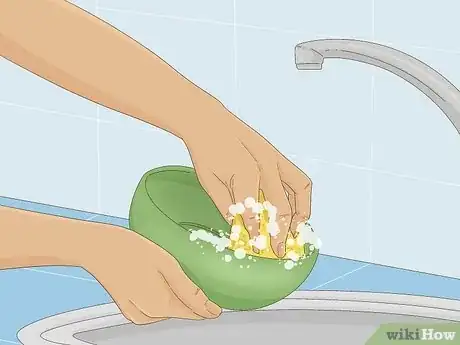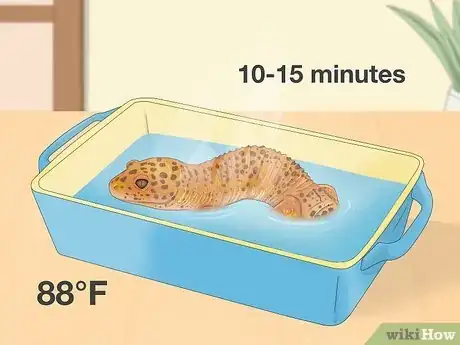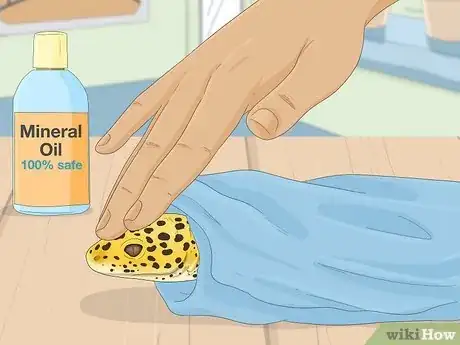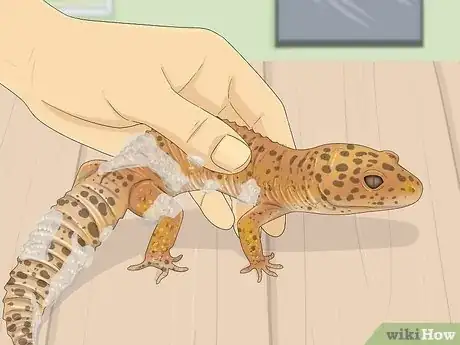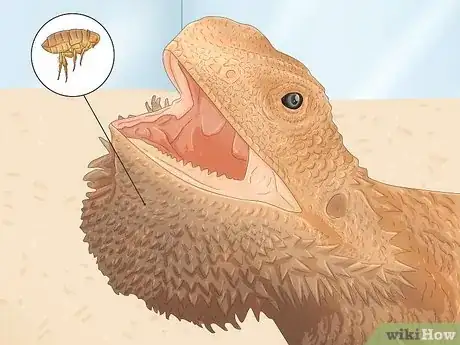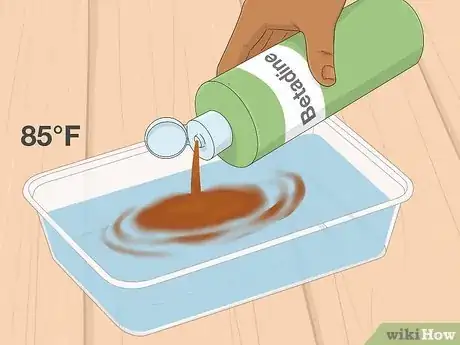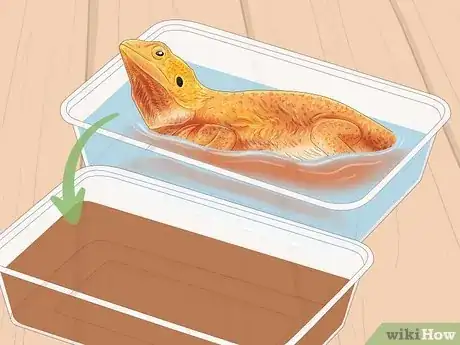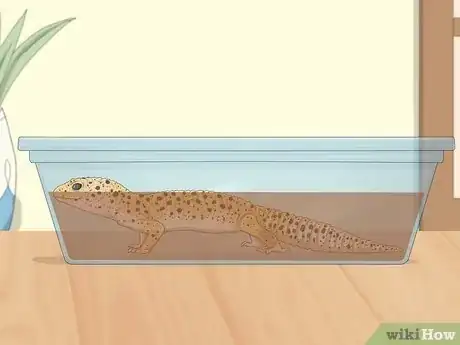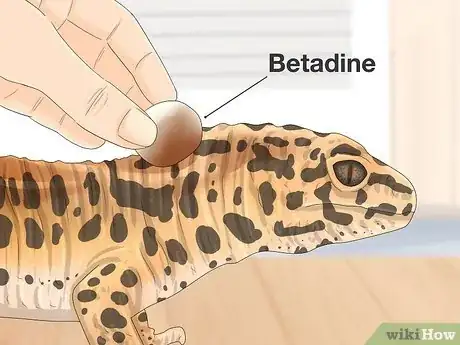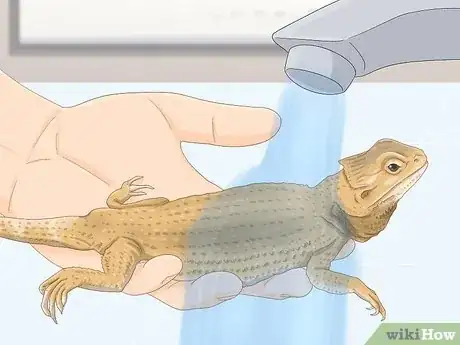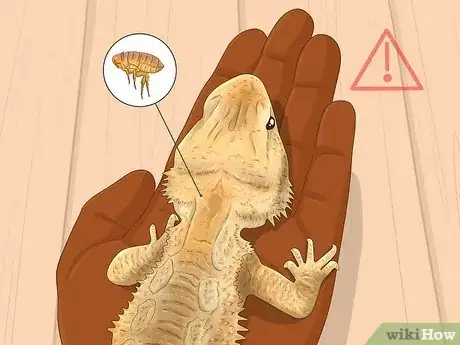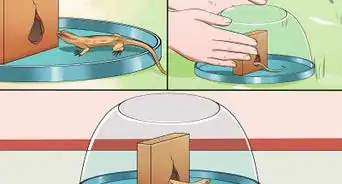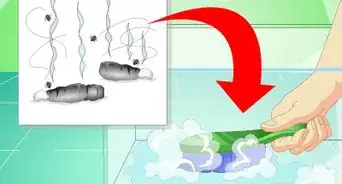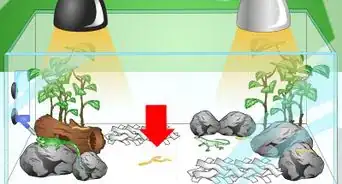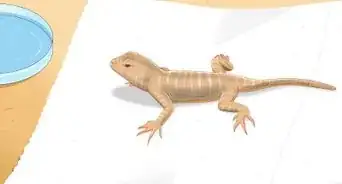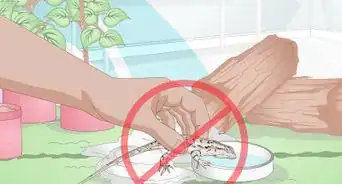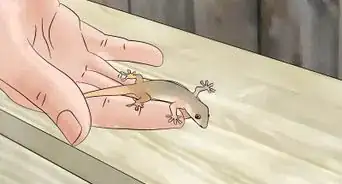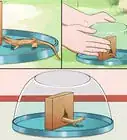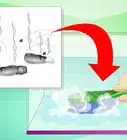This article was co-authored by Jeff Jensen and by wikiHow staff writer, Megaera Lorenz, PhD. Jeff Jensen is a Reptile Specialist and the Owner of The Reptile Zone out of Bend, Oregon. With decades of experience with reptiles and wildlife, Jeff specializes in providing advice and guidance on proper reptile care. As a former science teacher and employee of the San Antonio Zoo and an accomplished herpetologist, Jeff’s dedication to knowledge and ethical pet trade practices led to The Reptile Zone being awarded a “Mark of Excellence” Award by Intrepid Marketing in 2018.
There are 8 references cited in this article, which can be found at the bottom of the page.
This article has been viewed 29,821 times.
Many lizards enjoy the occasional soak in a water dish or bathing pool. Sometimes your lizard may need a more serious cleaning, however. If the lizard is shedding, a gentle bath can help ease the process and remove stubborn pieces of skin. A lizard with a mite infestation will benefit from a bath in diluted Betadine, which can both kill the mites and help heal any bites on the lizard’s skin.
Steps
Letting Your Lizard Bathe Itself
-
1Place a water bowl in your lizard’s habitat so it can bathe at any time. Most lizards enjoy soaking from time to time. Provide a shallow water bowl that is big enough that the lizard can completely submerge itself in it. Make sure the bowl is heavy enough that it won't tip over and keep it filled with clean, fresh water at all times.[1]
- Having access to a bath is especially helpful when your lizard is shedding, since the moisture can help soften and loosen the dead skin.
- You can also gently mist your lizard with a plant mister 2-3 times weekly.
-
2Change out the water in your lizard’s bowl daily. Empty your lizard’s bowl and refill it with clean, room-temperature water every day. If you provide water for your lizard in a large, shallow bowl, the water will evaporate quickly.[2] The water can also become contaminated if your lizard defecates or gets food or substrate in it.
- You may need to change the water more frequently than once a day if it becomes dirty quickly.
Advertisement -
3Clean and disinfect the water bowl weekly. Once a week, remove the bowl from the enclosure and scrub it down with a mild dish soap and hot water. You can disinfect the bowl by letting it soak for 2-3 minutes in a solution of 1–3 fluid ounces (30–89 mL) of bleach per 1 US quart (0.95 L) of water. Rinse the bowl thoroughly in clean water before refilling it and putting it back in the tank.[3]
- If you notice mineral deposits on the water bowl, try soaking it for a few minutes in warm white vinegar, then scrub the bowl and rinse it thoroughly in fresh water.
-
4Offer built-in bathing areas for larger lizards. Some types of large or partially aquatic lizards, such as Chinese water dragons and iguanas, can benefit from having a larger bathing area in their enclosure. Consider buying or building a “water terrarium” with a built-in pool for lizards like these.[4]
- Familiarize yourself with the needs of your lizard’s species before adding a large water feature to its environment.
- If your tank has a built-in pool, you will need to provide a filtration system to help keep the water clean between changes. Even with a filter, it’s important to completely change out the water and clean the swimming area at least once every 3-4 days.[5]
- You may also need to put a heater in the water to maintain an appropriate water temperature for your lizard (e.g., around 83–85 °F (28–29 °C) for an iguana).[6]
Bathing a Shedding Lizard
-
1Examine your lizard to determine if it needs help shedding. If your lizard is shedding, keep a close eye on it to see if the old skin appears to be coming off as it should. Most lizards complete a healthy shed in 1 to 3 weeks. If your lizard still hasn’t completely shed its skin at the end of a few weeks, it could probably benefit from a soak.[7]
- Un-shed skin tends to build up in areas such as around the lizard’s toes and tail, in the folds of skin around the neck and dewlap, and on features such as crests and spikes.
-
2Soak your lizard in warm water for 10-15 minutes. If your lizard is having a difficult shed, place it in a tub of shallow water and let it soak briefly to soften the un-shed skin. Keep the water temperature around 85–88 °F (29–31 °C).[8]
- Gently massage your lizard’s body as it soaks to loosen the dead skin.
- For smaller lizards, such as tiny anoles or house geckos, provide a humidified hideout rather than attempting to soak the lizard. You can purchase a humidity hide box at a pet supply store or build your own. Cut a hole in a lidded plastic container so that your lizard can enter, and fill two thirds of the container with moistened sphagnum moss.[9]
-
3Wrap your lizard in a moist towel for 5 minutes to soften any remaining skin. If your lizard still doesn’t manage to shed completely after a bath, take a warm, damp towel and loosely wrap the lizard in it. Make sure the lizard’s head is exposed. Wrap a dry towel around the wet towel and let the lizard remain wrapped for about 5 minutes.[10]
- After you take the lizard out of the wrap, check to see if there is still any dead skin around the toes and tail. If your lizard has a crest, spikes, or dewlap, check these areas as well.
-
4Rub mineral oil on any stubborn spots while the lizard is still damp. Right after bathing your lizard or placing it in a moist wrap, look to see if there are any especially thick or toughened layers of dead skin still clinging to areas like the toes or tail. Rub a little mineral oil onto these spots while they are still wet to lock in moisture and help soften the skin further.[11]
- Take care not to get any mineral oil in your lizard’s eyes.
-
5Gently massage any areas with stubborn dead skin. After bathing your lizard and applying mineral oil, carefully rub any areas where dead skin still remains. This can help loosen the skin so that it comes off more easily. Don’t try to peel or pull off any skin if it doesn’t come off readily.[12]
- You may need to repeat the process of bathing your lizard and applying mineral oil over a couple of days in order to fully loosen any stubborn skin.
- If your lizard is still having a lot of trouble shedding, take it to the vet for an evaluation. There might be an underlying health issue contributing to the problem.
Giving a Betadine Bath to Kill Mites
-
1Inspect your lizard for signs of mites. Lizard mites can give your lizard a dull appearance and may eventually cause illness if they are not treated. If you suspect your lizard has mites, look closely at its skin, especially around the eyes and in any folds or crevices. The mites will look like tiny, reddish dots moving around on your lizard’s skin.[13] If you do find mites, you can treat the problem by giving your lizard a Betadine bath.
- You might also see dead mites floating in your lizard’s water bowl.
-
2Fill a shallow tub with warm water and dilute Betadine. Put enough water in your bathing tub to reach about shoulder height on your lizard. Use water that is around 80–85 °F (27–29 °C). Add enough Betadine (povidone-iodine) to make the water the color of weak to medium-strength tea (i.e., clear and light to medium brown in color).[14]
- You can buy Betadine online or from most pharmacies.
-
3Let your lizard soak in plain water before putting it the Betadine bath. Fill a separate tub with plain, warm water and put your lizard in it for a few minutes. This will give the lizard an opportunity to drink, so it will be less tempted to drink the Betadine solution.[15]
- This will also give your lizard a chance to relieve itself before you put it in the Betadine soak.
-
4Put your lizard in the Betadine bath and let it soak for a few minutes. While the lizard is soaking, gently pour some of the bath water over it to make sure that any parts that are not submerged are exposed to the Betadine. Take care not to get any Betadine solution in your lizard’s eyes.[16]
- If your lizard is very small (e.g., an anole or house gecko) or belongs to a species that doesn’t spend a lot of time in water (such as a spiny-tailed lizard), don’t leave it soaking in the tub for a long time. Just place the lizard in the bath long enough to cover it in the solution, then remove it.
- Larger or more aquatic lizards, such as iguanas or Chinese water dragons, can soak for up to half an hour.
- If your lizard relieves itself in the water, empty the bath and refill it with a fresh Betadine solution.
-
5Wipe the lizard with a Betadine-soaked cloth after it’s done soaking. Dip a soft cloth in the Betadine solution, then use the cloth to gently wipe your lizard’s body. Focus on areas like the joints between the legs and the body, any folds of skin around the head and neck, and any spikes or crests. Use a cotton swab to apply betadine solution to the lizard’s face, being careful not to get any in the eyes or nose.[17]
- Closely inspect any areas where mites might hide out, such as in between spines along the lizard’s back. If you see any mites hiding in those areas, swab them down carefully with a Betadine-soaked cotton swab.
- If you’re concerned that your lizard is too small to soak, skip the bath and just wipe down the lizard with the Betadine-soaked cloth.
-
6Rinse your lizard with clean water. After you’ve thoroughly treated your lizard with the Betadine solution, place it in a new bath with fresh water. Make sure the water is 80–85 °F (27–29 °C). Pour a little of the water over the lizard to rinse off any remaining betadine.[18]
- If your lizard is too small or does not like soaking in a bath, you can simply rinse it with warm water instead of soaking it.
- Keep the lizard in a warm, dry holding area until you are able to finish cleaning and disinfecting its habitat. Otherwise, it may become re-infested with mites.
-
7Disinfect your lizard’s habitat before putting your lizard back. If you bathe your lizard and then return it without cleaning the habitat first, the mite infestation will quickly return. Before you put the lizard back, remove all the contaminated substrate and dispose of it, preferably outside your home. Wipe down all surfaces of the enclosure with hot, soapy water and rinse it thoroughly. Boil any rocks or branches from the habitat in water for 20-30 minutes.[19]
- If the habitat is glass, you can soak it for 10 minutes in a solution of 1⁄2 cup (120 mL) of bleach per 1 gallon (3.8 L) of water. You can also use this solution to disinfect food and water dishes, rocks and branches, and décor. Make sure to rinse off the bleach solution thoroughly with clean water.
- Wipe down any light fixtures and heating elements with a damp cloth to remove stray mites, eggs, and mite feces.
- Vacuuming around the enclosure will also help pick up any stray mites that have gotten out of the habitat.
-
8Fumigate the tank with a no-pest strip. While cleaning and disinfecting the tank will remove most of the mites, you can kill any that remain by fumigating the tank with a pesticide. Put the no-pest strip on a piece of foil in the bottom of the tank and seal up the tank to make it air tight. Leave the strip in place for about 3 hours, then remove it and ventilate the tank for several more hours before putting your lizard back in.[20]
- You can purchase no-pest strips online or at many department or home-supply stores. If you can’t find a no-pest strip, you can use a cat flea collar instead.
- Help the ventilation process along by opening a window and turning on a fan in the room where you keep the tank.
-
9Keep an eye out for a returning mite infestation. Check the lizard and its environment regularly over the next 2 to 6 weeks. If you see any sign of the mites returning, repeat the bathing and disinfection process.[21]
- You may find it helpful to replace your lizard’s regular substrate with paper towels for the next few weeks, since mites show up best against a light background.
Community Q&A
Did you know you can get answers researched by wikiHow Staff?
Unlock staff-researched answers by supporting wikiHow
-
QuestionHow do you tell the difference between a boy and a girl blue belly lizard?
 wikiHow Staff EditorThis answer was written by one of our trained team of researchers who validated it for accuracy and comprehensiveness.
wikiHow Staff EditorThis answer was written by one of our trained team of researchers who validated it for accuracy and comprehensiveness.
Staff Answer wikiHow Staff EditorStaff Answer
wikiHow Staff EditorStaff Answer -
QuestionHow do I know when to clean the cage?
 Community AnswerIt's best to just get on a regular cleaning schedule as opposed to waiting for the cage to get dirty. I would recommend cleaning it out once a week.
Community AnswerIt's best to just get on a regular cleaning schedule as opposed to waiting for the cage to get dirty. I would recommend cleaning it out once a week. -
QuestionShould I wash a wild lizard when I find it?
 Community AnswerNo. Some species cannot have contact with human/bottled/tap water. It can kill them. It's best to catch them with clean gloves, just in case.
Community AnswerNo. Some species cannot have contact with human/bottled/tap water. It can kill them. It's best to catch them with clean gloves, just in case.
Warnings
- Never attempt to peel or pull dead skin off your shedding lizard. This can seriously damage your lizard’s delicate new skin.⧼thumbs_response⧽
References
- ↑ http://www.reptilesmagazine.com/Reptile-Health/Habitats-Care/Reptile-Water-Requirements/
- ↑ http://www.reptilesmagazine.com/Reptile-Health/Habitats-Care/Reptile-Water-Requirements/
- ↑ http://www.reptilesmagazine.com/Reptile-Health/Habitats-Care/Reptile-Water-Requirements/
- ↑ https://infolific.com/pets/lizards/the-water-terrarium/
- ↑ http://www.reptilesmagazine.com/Chinese-Water-Dragon-Care/
- ↑ http://www.anapsid.org/iguana/swimming.html
- ↑ http://www.anapsid.org/shedding.html
- ↑ http://www.anapsid.org/shedding.html
- ↑ http://www.anapsid.org/microclimates.html
- ↑ http://www.anapsid.org/shedding.html
- ↑ http://www.anapsid.org/shedding.html
- ↑ http://www.anapsid.org/shedding.html
- ↑ http://www.reptilesmagazine.com/Snake-Care/How-to-Recognize-and-Treat-Reptile-Ectoparasites/
- ↑ http://www.anapsid.org/mites.html
- ↑ http://www.anapsid.org/mites.html
- ↑ http://www.anapsid.org/mites.html
- ↑ http://www.anapsid.org/mites.html
- ↑ http://www.anapsid.org/mites.html
- ↑ http://www.anapsid.org/mites.html
- ↑ http://www.anapsid.org/mites.html
- ↑ http://www.anapsid.org/mites.html
About This Article
To give a lizard a bath, all you need to do is place a water bowl filled with clean, fresh water in its habitat so it can bathe itself. Just make sure you change out the water every day and disinfect the bowl with bleach and water once a week. If you have a large lizard, like a Chinese water dragon or an iguana, you may want to get a tank with a built-in pool so your lizard has enough room to bathe itself. To learn how to bathe a lizard that's shedding, scroll down!
